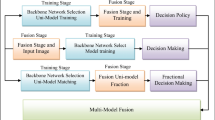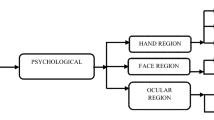Abstract
Achieving higher recognition performance in uncontrolled scenarios is a key issue for ear biometric systems. It is almost difficult to generate all discriminative features by using a single feature extraction method. This paper presents an efficient method by combining the two most successful local feature descriptors such as Pyramid Histogram of Oriented Gradients (PHOG) and Local Directional Patterns (LDP) to represent ear images. The PHOG represents spatial shape information and the LDP efficiently encodes local texture information. As the feature sets are curse of high dimension, we used principal component analysis (PCA) to reduce the dimension prior to normalization and fusion. Then, two normalized heterogeneous feature sets are combined to produce single feature vector. Finally, the Kernel Discriminant Analysis (KDA) method is employed to extract nonlinear discriminant features for efficient recognition using a nearest neighbor (NN) classifier. Experiments on three standard datasets IIT Delhi version (I and II) and University of Notre Dame collection E reveal that the proposed method can achieve promising recognition performance in comparison with other existing successful methods.










Similar content being viewed by others
References
Abate AF, Nappi M, Riccio D, Ricciardi S (2006) Ear recognition by means of a rotation invariant descriptor. In: 2006 international conference on pattern recognition, (ICPR), vol 4, pp 437–440
Ahonen T, Hadid A, Pietikainen M (2006) Face description with local binary patterns: application to face recognition. IEEE Trans Pattern Anal Mach Intell 28 (12):2037–2041
Anwar AS, Ghany KKA, Elmahdy H (2015) Human ear recognition using geometrical features extraction. Procedia Comput Sci 65:529–537
Arbab-Zavar B, Nixon M, et al. (2007) On shape-mediated enrolment in ear biometrics. In: Bebis G, Boyle R, Parvin B (eds) Advances in visual computing, vol 4842. Springer, Berlin/Heidelberg LNCS, pp 549–558
Badrinath G, Gupta P (2009) Feature level fused ear biometric system. In: 7th international conference on advances in pattern recognition (ICAPR), pp 197–200
Basit A, Shoaib M (2014) A human ear recognition method using nonlinear curvelet feature subspace. Int Jnl Comput Math 91(3):616–624
Benzaoui A, Hadid A, Boukrouche A (2014) Ear biometric recognition using local texture descriptors. J Electron Imaging 23(5):053008–053008
Bosch A, Zisserman A, Munoz X (2007) Representing shape with a spatial pyramid kernel. In: The ACM international conference on image and video retrieval
Burge M, Burger W (1998) Ear biometrics. In: Jain AK, Bolle R, Pankanti S (eds), pp 273–285
Bustard JD, Nixon MS (2010) Toward unconstrained ear recognition from two-dimensional images. IEEE Trans Syst Man Cybern Syst Hum 40(3):486–464
Chang K, Bowyer KW, Sarkar S, Victor B (2003) Comparison and combination of ear and face images in appearance-based biometrics. IEEE Trans Pattern Anal Mach Intell 25:1160–1165
Choras M (2008) Perspective methods of human identification: ear biometrics. Opto-Electron Rev 16(1):85–96
Choras M, Choras RS (2006) Geometrical algorithms of ear contour shape representation and feature extraction. In: 2006 IEEE international conference on intelligent systems design and applications (ISDA), pp 451–456
Chen S, Liu C (2011) Discriminant analysis of haar features for accurate eye detection. In: 15th international conference on image processing, computer vision, and pattern recognition. Las Vegas, Nevada, USA
Chen S, Liu C (2012) Various discriminatory features for eye detection. In: Cross disciplinary biometric systems. Springer, Berlin, pp 183–203
Chen S, Liu C (2014) Clustering-based discriminant analysis for eye detection. Trans Image Process 23(4):1629–1638
Dalal N, Triggs B (2005) Histograms of oriented gradients for human detection. In: 2005 IEEE computer society conference on computer vision and pattern recognition (CVPR), no 1, pp 886–893
Damer N, Führer B (2012) Ear recognition using multi-scale histogram of oriented gradients. In: IEEE international conference on intelligent information hiding and multimedia signal processing (IIH-MSP), pp 21–24
Emersic Z, Struc V, Peer P (2017) Ear recognition: more than a survey. Neurocomputing 255:26–39
Guo Y, Xu Z (2008) Ear recognition using a new local matching approach. In: 15th IEEE international conference on image processing (ICIP), pp 289–292
Hotelling H (1933) Analysis of a complex of statistical variables into principal components. J Educ Psychol 24(6):417
Huang Z, Liu Y, Li C, Yang M, Chen L (2016) A robust face and ear based multimodal biometric system using sparse representation. Pattern Recogn 46 (8):2156–2168
Hurley DJ, Nixon MS, Carter JN (2002) Force field energy functional for image feature extraction. Image Vis Comput 20(5-6):311–317
Iannarelli AV (1989) Ear identification. Paramont Publishing Company, Paramount
IIT Delhi Ear Database Version 1. http://web.iitd.ac.in/biometrics/Database_Ear.htm
Jabid T, Kabir MH, Oksam C (2010) Local Directional Pattern (LDP) for face recognition. In: International conference on consumer electronics Consumer Electronics (ICCE), pp 329–330
Kim KI, Jung K, Kim HJ (2002) Face recognition using kernel principal component analysis. IEEE Signal Process Lett 9(2):40–42
Kumar A, Zhang D (2007) Ear authentication using log-gabor wavelets. In: International society for optics and photonics on biometric technology for human identification IV, vol 6539, p 65390A
Kumar A, Wu C (2012) Automated human identification using ear imaging. Pattern Recogn 3:56–968
Lei S, Qi M (2016) Multimodal recognition method based on ear and profile face feature fusion. Int Jnl Signal Process Image Process Pattern Recogn 9(1):33–42
Liu C, Wechsler H (1998) Enhanced fisher linear discriminant models for face recognition. In: 14th IEEE international conference on pattern recognition, vol 2, pp 1368–1372
Liu Q, Huang R, Lu H, Ma S (2002) Face recognition using kernel-based fisher discriminant analysis. In: 5th IEEE international conference on automatic face and gesture recognition, pp 197–201
Lowe DG (2004) Distinctive image features from scale-invariant keypoints. Int Jnl Comput Vis 60(2):91–110
Lu L, Xiaoxun Z, Youdong Z, Yunde J (2006) Ear recognition based on statistical shape model. In: International conference on innovative computing, information and control (ICICIC), pp 353–356
Marcolin F, Vezzetti E (2017) Novel descriptors for geometrical 3D face analysis. Multimed Tools Appl 76(12):13805–13834
Nanni L, Lumini A (2007) A multi-matcher for ear authentication. Pattern Recogn Lett 28:2219–2226
Nanni L, Lumini A (2009) Fusion of color spaces for ear authentication. Pattern Recogn 42(9):1906–1913
Nosrati MS, Faez K, Faradji F (2007) Using 2D wavelet and principal component analysis for personal identification based on 2D ear structure. In: 2007 IEEE international conference on intelligent and advanced systems (ICIAS), pp 616–620
Pan X, Cao Y, Xu X, Lu Y, Zhao Y (2008) Ear and face based multimodal recognition based on KFDA. In: IEEE international conference on audio, language and image processing (ICALIP), pp 965–969
Pflug A, Busch C (2012) Ear biometrics: a survey of detection, feature extraction and recognition methods. IET Biometrics 1(2):114–129
Prakash S, Gupta P (2011) An efficient ear recognition technique invariant to illumination and pose. Telecommunication System Jnl, special issue on Signal Processing Applications in Human Computer Interaction (30):38–50
Rathore R, Prakash S, Gupta P (2013) Efficient human recognition system using ear and profile face. In: 2013 6th IEEE international conference on biometrics: theory, applications and systems (BTAS), pp 1–6
Sana A, Gupta P (2007) Ear biometrics: a new approach. In: International conference on advances in pattern recognition
Sarangi PP, Panda M, Mishra BP, Dehuri S (2017) An automated ear localization technique based on modified hausdorff distance. In: International conference on computer vision and image processing. (CVIP). Springer, Singapore, pp 229–240
Sarangi PP, Mishra BSP, Dehuri S (2017) Pyramid histogram of oriented gradients based human ear identification. Int Jnl Control Theory Apps 10(15):125–133
Shailaja D, Gupta P (2006) A simple geometric approach for ear recognition. In: 2006 IEEE international conference on information technology (ICIT), pp 164–167
University of Notre Dame Ear Database Collection E., http://www.nd.edu/cvrl/CVRL/DataSets.html
Vezzetti E, Marcolin F, Tornincasa S, Ulrich L, Dagnes N (2017) 3D geometry-based automatic landmark localization in presence of facial occlusions. Multimed Tools Appl 2017:1–29
Victor B, Bowyer K, Sarkar S (2002) An evaluation of face and ear biometrics. In: International conference on pattern recognition (ICPR), vol 1, pp 429–432
Wang Y, Mu ZC, Zeng H (2008) Block-based and multi-resolution methods for ear recognition using wavelet transform and uniform local binary patterns. In: 2009 19th IEEE international conference on pattern recognition (ICPR), pp 1–4
Xie Z, Mu Z (2008) Ear recognition using LLE and IDLLE algorithm. In: 19th international conference on pattern recognition (ICPR), pp 1–4
Xu X, Mu Z (2007) Feature fusion method based on KCCA for ear and profile face based multimodal recognition. In: 2007 IEEE international conference on automation and logistics, pp 620–623
Yazdanpanah AP, Faez K, Amirfattahi R (2010) Multimodal biometric system using face, ear and gait biometrics. In: 10th IEEE international conference on information sciences signal processing and their applications (ISSPA), pp 251–254
Yuan L, chun Mu Z, Zhang Y, Liu K (2006) Ear recognition using improved non-negative matrix factorization. In: 18th international conference on pattern recognition (ICPR), vol 4, pp 501–504
Yuan L, Li C, Mu Z (2012) Ear recognition under partial occlusion based on sparse representation. In: IEEE international conference on system science and engineering (ICSSE), pp 349–352
Yuan L, Mu Z, Liu Y (2006) Multimodal recognition using face profile and ear. In: IEEE international symposium on systems and control in aerospace and astronautics, p 5
Zhang HJ, Mu ZC, Qu W, Liu LM, Zhang CY (2005) A novel approach for ear recognition based on ICA and RBF network. In: IEEE international conference on machine learning and cybernetics, vol 7, pp 4511–4515
Zuiderveld K (1994) Graphics Gems IV, chap. Contrast limited adaptive histogram equalization. Academic Press Professional, Inc, Cambridge, pp 474–485
Author information
Authors and Affiliations
Corresponding author
Additional information
Publisher’s Note
Springer Nature remains neutral with regard to jurisdictional claims in published maps and institutional affiliations.
Rights and permissions
About this article
Cite this article
Sarangi, P.P., Mishra, B.S.P. & Dehuri, S. Fusion of PHOG and LDP local descriptors for kernel-based ear biometric recognition. Multimed Tools Appl 78, 9595–9623 (2019). https://doi.org/10.1007/s11042-018-6489-0
Received:
Revised:
Accepted:
Published:
Issue Date:
DOI: https://doi.org/10.1007/s11042-018-6489-0




